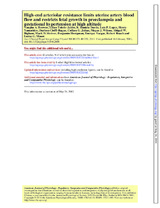Mostrar el registro sencillo del ítem
High-end arteriolar resistance limits uterine artery blood flow and restricts fetal growth in preeclampsia and gestational hypertension at high altitude
| dc.contributor.author | Browne, Vaughn A | |
| dc.contributor.author | Toledo-Jaldín, Lilian | |
| dc.contributor.author | Dávila, R Daniela | |
| dc.contributor.author | López, Luis P | |
| dc.contributor.author | Yamashiro, Henry | |
| dc.contributor.author | Cioffi-Ragan, Darleen | |
| dc.contributor.author | Julian, Colleen Glyde | |
| dc.contributor.author | Wilson, Megan J | |
| dc.contributor.author | Bigham, Abigail W | |
| dc.contributor.author | Shriver, Mark D | |
| dc.contributor.author | Honigman, Benjamín | |
| dc.contributor.author | Vargas, Enrique | |
| dc.contributor.author | Roach, Robert | |
| dc.contributor.author | Moore, Lorna G | |
| dc.date.accessioned | 2016-09-28T12:54:45Z | |
| dc.date.available | 2016-09-28T12:54:45Z | |
| dc.date.issued | 2011 | |
| dc.identifier.uri | http://repositorio.umsa.bo/xmlui/handle/123456789/8053 | |
| dc.description.abstract | The reduction in infant birth weight and increased frequency of preeclampsia (PE) in high-altitude residents have been attributed to greater placental hypoxia, smaller uterine artery (UA) diameter, and lower UA blood flow (QUA). This cross-sectional case-control study determined UA, common iliac (CI), and external iliac (EI) arterial blood flow in Andeans residing at 3,600–4,100 m, who were either nonpregnant (NP, n 23), or experiencing normotensive pregnancies (NORM; n 155), preeclampsia (PE, n 20), or gestational hypertension (GH, n 12). Pregnancy enlarged UA diameter to 0.62 cm in all groups, but indices of end-arteriolar vascular resistance were higher in PE or GH than in NORM. QUA was lower in early-onset ( 34 wk) PE or GH than in NORM, but was normal in late-onset ( 34 wk) illness. Left QUA was consistently greater than right in NORM, but the pattern reversed in PE. Although QCI and QEI were higher in PE and GH than NORM, the fraction of QCI distributed to the UA was reduced 2- to 3-fold. Women with early-onset PE delivered preterm, and 43% had stillborn small for gestational age (SGA) babies. Those with GH and late-onset PE delivered at term but had higher frequencies of SGA babies (GH 50%, PE 46% vs. NORM 15%, both P 0.01). Birth weight was strongly associated with reduced QUA (R2 0.80, P 0.01), as were disease severity and adverse fetal outcomes. We concluded that high end-arteriolar resistance, not smaller UA diameter, limited QUA and restricted fetal growth in PE and GH. These are, to our knowledge, the first quantitative measurements of QUA and pelvic blood flow in early- vs. late-onset PE in high-altitude residents. | es_ES |
| dc.language.iso | en | es_ES |
| dc.publisher | Am J Physiol Regul Integr Comp Physiol | es_ES |
| dc.subject | RESTRICCIÓN CRECIMIENTO FETAL | es_ES |
| dc.subject | HIPERTENSIÓN GESTACIONAL | es_ES |
| dc.subject | ALTURA | es_ES |
| dc.title | High-end arteriolar resistance limits uterine artery blood flow and restricts fetal growth in preeclampsia and gestational hypertension at high altitude | es_ES |
| dc.type | Article | es_ES |

